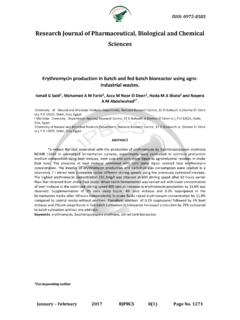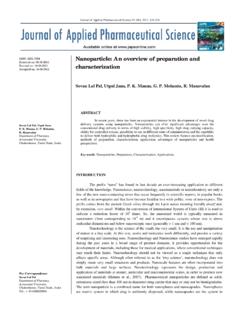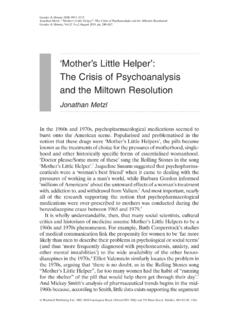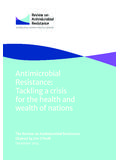Transcription of Research Journal of Pharmaceutical, Biological and ...
1 ISSN: 0975-8585. Research Journal of pharmaceutical , Biological and Chemical Sciences Development of the technology of combined meat product using biomass from the spleen of horses Sholpan Baytukenova1, Mukhtarbek Kakimov1, Saule Baytukenova2, Kairat Bekbayev1, Zhayik Tokhtarov3*, and Aidyn Igenbayev3. Kazakh AgroTechnical University, Zhenis avenue, 62, Astana, 010011, Kazakhstan. 2 The Korkyt Ata Kyzylorda State University, Aiteke Bi 29A, Kyzylorda, 120014, Kazakhstan. 3 Shakarim State University of Semey, Glinki street, 20A, Semey, 071412, Kazakhstan. ABSTRACT. In this paper the technology and formulation of biomass from the spleen of horse and new type of boiled sausage is presented.
2 The chemical composition of biomass is as follows: water content - 68,62 %, protein - %, fat - %, carbohydrates - %. Introduction of biomass to the formulation of boiled sausage improves the organoleptic indicators (consistence, color and taste of the finished product), amino acid and vitamin compositions. Keywords spleen, horse, biomass, boiled sausage, technology. *Corresponding author January February 2017 RJPBCS 8(1) Page No. 271. ISSN: 0975-8585. INTRODUCTION. At the present stage in the field of new technologies in the meat industry, the main task is the need to develop food products, which are focused on boosting the immune protection of an organism of the person.
3 The scientists of different countries and the Republic of Kazakhstan for many years carried out scientific Research on the development of new technologies for the production of medicines from animal products containing biologically active substances. In particular, biologically active substances raising cellular and humoral immunity, see the bodies immune system of animals, including the spleen [1]. In the famous developed the technology of production of wide range of meat products, providing a complete recycling of secondary raw materials slaughter of animals for food and medicinal purposes, insufficient attention is paid to the spleen horses.
4 The traditional technology of processing of the spleen envisages mainly the production of it technical products and fodder flour. Meanwhile, it is known that in the spleen contains all the necessary for a human organism biologically active substances: vitamins, amino acids, enzymes, hormones, immune and mineral substances [2, 3]. Targeted food fortification these components can be made by the proper use of the spleen horses. The aim of this work is the Research and development of technologies of biomass from the spleen horses for meat products. First developed rational use spleen horses in the form of biomass, increases the immune status of the organism.
5 On the basis of comprehensive studies have established a pattern of connection soluble globulin protein and albumen faction, lipids, that have enabled the development of compounding and technology of preparation of biomass consisting of the spleen, bone fat, rice flour, egg melange and extract. The proved possibility of introduction of biomass in meat products in order to enrich them with proteins, lipids, carbohydrates, bioactive substances. Optimal dose are made of biomass in meat products. The use of biomass contributes to increased moisture-tie capacity, guarantee improvements flavoring, Biological and immunomodulating properties of the finished product [4, 5].
6 In recent years a great attention is drawn to the biologically active substances of peptide structure, providing immunological action and having the ability to restore immunity in case of oppression that increase the body's resistance to infections, and adverse environmental factors [6]. It is known that for medicinal Biological products peptide that enhance the body's immune defenses, can serve as animal bodies. Such bodies include the spleen slaughter of animals [7]. Given the high efficiency spleen slaughter of animals in medicine for the treatment of a large number of pathologies, it should be assumed that the spleen will also find wide application in the meat industry.
7 The analysis of literary sources to be able to conclude that the spleen is slaughtered animals are not widely used for food purposes, although in the modern view, and food and Biological value, it has the properties that makes it usable in the production of special products. Therefore, these circumstances have caused a targeted Research spleen horses and find ways of using them in the production of special products [8, 9]. RESULTS AND DISCUSSION. In this paper we have chosen exactly spleen horses, because in recent years in Kazakhstan develops herd horse breeding, and the livestock industry is becoming high-value and cost effective.
8 Therefore, special attention is paid to the rational use of locally available animal - horse-flesh. In experimental studies spleen used directly after slaughter from healthy animals and higher secondary fatness. The complex study of security spleen horses (table 1.) The results of the Research showed lack of pesticides and bacteria group Escherichia coli, Proteus, , and Salmonella in the spleen, which testifies to the ecologically clean raw materials. On the basis of the received results it is proposed to use the spleen horses for producing biomass. January February 2017 RJPBCS 8(1) Page No.
9 272. ISSN: 0975-8585. Table 1: Content of pesticides in the spleen of slaughtered animals MPL (maximum permissible The content of toxic chemicals in the spleen, mg/kg Toxic level). chemicals Cattle Cattle Cattle Pigs Pigs Pigs Horses Horses Horses DDT 0,1 not found not found not found DDE 0,1 not found not found not found DDD 0,1 not found not found not found HCH 0,1 not found not found not found ldrin not allowed not found not found not found Heptachlor not allowed not found not found not found Karbofos not allowed not found not found not found Metaphos not allowed not found not found not found Chlorophos not allowed not found not found not found DWF not allowed not found not found not found When compiling recipes biomass and new product came from the fact that the product is enriched with bioactive components, must be accessible to the mass consumer, so it was necessary to optimize a prescription mixture.
10 As a result of mathematical modeling formulas, optimal ratio of ingredients: 1) mass fraction of biomass from the spleen, %: spleen - ; extract - ; melted bone fat - 6,0; rice flour - 10,0; melange - ;. 2) mass fraction of boiled sausages of the I grade, %: horse meat of the 1st category - ; pork bold - ; pork bacon - 10,0; biomass - On the basis of experimental researches by definition of technological modes of production of biomass from the spleen (BMS) proposed the following technological scheme (figure 1). Fig. 1: Technological scheme of production of biomass from the spleen January February 2017 RJPBCS 8(1) Page No.






